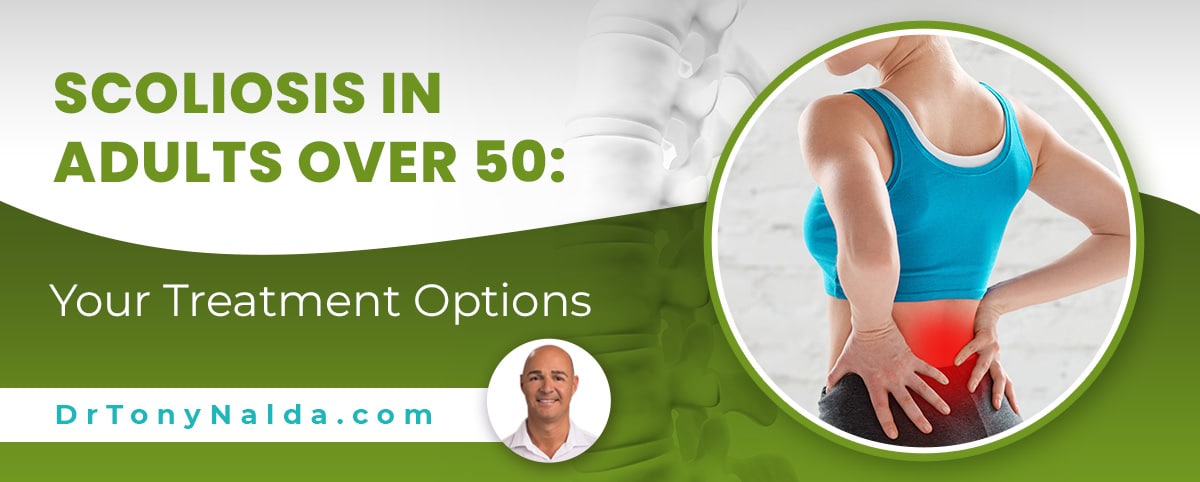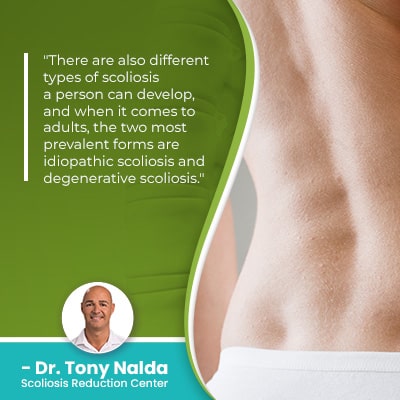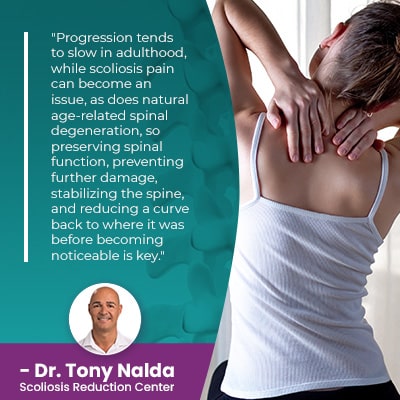Scoliosis In Adults Over 50: Your Treatment Options

When it comes to treating scoliosis in adults, the priority shifts from that of addressing the condition in children, and this is largely due to progression and pain. Continue reading to find out how the focus of adult scoliosis treatment is different than in the treatment of adolescent scoliosis.
Scoliosis ranges widely in severity from mild to moderate and severe to very severe; in addition, the condition affects all ages. When it comes to scoliosis in adults, the two most common types are idiopathic scoliosis and degenerative scoliosis; adults over 50 are most commonly affected by degenerative scoliosis.
There are different treatment options for scoliosis, and effective treatment plans need to be designed around key patient/condition variables, one of which is patient age.
Table of Contents
Diagnosing Scoliosis in Adults
Being diagnosed with scoliosis means an unnatural sideways curvature of the spine has developed, and as a scoliotic curve also twists, the rotational component makes it a complex 3-dimensional condition.
In addition, a scoliotic curve has to be of a minimum size to be officially diagnosed as scoliosis: minimum Cobb angle measurement of at least 10 degrees.
Part of the diagnostic process involves further classifying conditions based on important patient/condition variables, one of which is condition severity.
Conditions are classified as mild to moderate, severe to very severe, and this is determined by a patient's Cobb angle:
- Mild scoliosis: Cobb angle measurement of between 10 and 25 degrees
- Moderate scoliosis: Cobb angle measurement of between 25 and 40 degrees
- Severe scoliosis: Cobb angle measurement of 40+ degrees
- Very-severe scoliosis: Cobb angle measurement of 80+ degrees
When the spine's natural and healthy curves are in place, its vertebrae (bones of the spine) are aligned in a straight and neutral position, but as an unnatural spinal curvature of the spine develops, the vertebrae at its apex are becoming unnaturally tilted, causing them to shift out of alignment with the rest of the spine.
A misaligned spine is one that's not going to be as strong, flexible, or function optimally; the goal of scoliosis treatment is to reduce the size of the unnatural spinal curve on a structural level so the spine's alignment is improved and its biomechanics restored.
In addition, scoliosis is a progressive condition, meaning it has it in its very nature to get worse over time, and while scoliosis is incurable, it can be highly treatable.
 There are also different types of scoliosis a person can develop, and when it comes to adults, the two most prevalent forms are idiopathic scoliosis and degenerative scoliosis.
There are also different types of scoliosis a person can develop, and when it comes to adults, the two most prevalent forms are idiopathic scoliosis and degenerative scoliosis.
Adult Scoliosis: Idiopathic Scoliosis and Degenerative Scoliosis
The most common types of scoliosis to affect adults is the most-prevalent form of scoliosis amongst all age groups: idiopathic scoliosis.
The idiopathic designation means not clearly associated with a single-known cause, and adolescent idiopathic scoliosis, diagnosed between the ages of 10 and 18, is the condition's most common type overall.
Cases of idiopathic scoliosis in adults are cases of adolescent idiopathic scoliosis that were undiagnosed and untreated during adolescence; this is a common scenario.
Scoliosis doesn't become a compressive condition until skeletal maturity is reached in adulthood, and this is when the condition tends to become painful.
Compression of the spine and its surrounding muscles and nerves is the main cause of condition-related pain, and in adulthood, pain is the main scoliosis symptom that brings adult patients in to see me for a diagnosis and treatment.
The unfortunate reality is that had these patients received treatment during adolescence, their spines would be in far better shape; scoliosis only gets more complex to treat as it progresses.
After idiopathic scoliosis, the next most common type to affect adults is degenerative scoliosis, and this is the most common type to affect adults over 50.
Degenerative Scoliosis
Degenerative scoliosis is caused by natural age-related spinal degeneration, which is most common in adults over the age of 50, and tends to involve the spine's intervertebral discs starting to deteriorate.
Degenerative scoliosis is also more prevalent in females, and this is related to changes in hormone levels and bone density caused by menopause.
Degenerative changes in the spine most often involves the discs, and as they play so many important roles in preserving spinal health and function (providing cushioning between adjacent vertebrae, acting as the spine's shock absorbers, facilitating flexible movement, and preventing friction), once the discs degenerate, the spine becomes unstable.
The spine consists of vertebrae stacked on top of one another, and adjacent vertebrae are separated by an intervertebral disc.
When a disc starts to deteriorate, it often becomes desiccated and changes shape as a result, and this change in shape affects its surroundings, which includes the position of adjacent vertebrae that attach to the disc in between.
So the underlying cause of adult degenerative scoliosis is natural age-related spinal degeneration, but certain lifestyle choices also have a cumulative effect that can increase the severity and rate of spinal degeneration: carrying excess weight strains the joints of the spine, chronic poor posture introduces adverse spinal tension, a low activity level is contrary to the spine's movement-based design, excessive consumption of alcohol and/or smoking can contribute to disc desiccation over time, and repeatedly lifting heavy objects incorrectly exposes the spine to uneven wear and tear and makes it vulnerable to injury.
So when it comes to getting adult scoliosis diagnosed, it's most often pain, caused by compression, such as localized back pain and pain that radiates into the body's extremities due to nerve compression that brings adults in for a diagnosis and treatment.
So now that we have explored the most prevalent types of scoliosis in adults, adult idiopathic scoliosis and degenerative scoliosis, it's time to talk about treating adult scoliosis.
Adult Scoliosis Treatment
When it comes to treating scoliosis in children, a large focus is monitoring for progression, and this is because the trigger for scoliosis progression is growth and development.
In the condition's most-prevalent form, adolescent idiopathic scoliosis, these patients are at risk for rapid-phase progression because of the stage of puberty with its rapid and unpredictable growth spurts.
A focus of treating adolescents is to reduce the size of the scoliotic curve, and to hold the reduction despite the constant trigger of growth; however, in adults, as the trigger of growth is removed, the focus can shift from monitoring for, and counteracting, progression to improving spinal stability and pain relief.
As pain is the main symptom of adult scoliosis, pain management has to be a focus of treatment as back pain, leg pain, and radiating pain in the hands and feet can affect adult patients' quality of life.
All cases of scoliosis require treatment; as a progressive condition, the best time to start scoliosis treatment is always now, regardless of patient age.
While achieving a curvature reduction is a goal with every scoliosis patient, with my adults over 50, that goal is prioritized differently.
 Progression tends to slow in adulthood, while scoliosis pain can become an issue, as does natural age-related spinal degeneration, so preserving spinal function, preventing further damage, stabilizing the spine, and reducing a curve back to where it was before becoming noticeable is key.
Progression tends to slow in adulthood, while scoliosis pain can become an issue, as does natural age-related spinal degeneration, so preserving spinal function, preventing further damage, stabilizing the spine, and reducing a curve back to where it was before becoming noticeable is key.
With the treatment of scoliosis in adults over 50, there is more time, less concern about counteracting progression and working towards significant curvature reductions to overcorrect, but more so to work towards a curve reduction that offers patients a level of improvement and pain relief.
Condition-specific chiropractic care is applied in an effort to reposition the curve's most-tilted vertebrae back into alignment with the rest of the spine, restoring as much of the spine's natural curves as possible.
Here at the Scoliosis Reduction Center, my non operative treatment also includes physical therapy that can improve posture, address any related muscle imbalance, and increase core strength so the spine's surrounding muscles could optimally support it.
Corrective bracing, like the ScoliBrace, is used differently in the treatment of adult scoliosis; here, it's used more for stabilizing the spine and providing short-term pain relief than for augmenting corrective results.
Improving disc health is often a part of treating scoliosis in older adults, and this can include lifestyle guidance, relieving pressure on the discs by straightening the spine, and improving circulation around an affected disc so it can absorb what it needs for repair from its surroundings.
Helping patients establish a home-rehabilitation program is important for sustaining treatment results and further stabilizing the spine.
Many patients find that adult scoliosis treated proactively can offer significant condition improvement, without the need for invasive spinal surgery.
Conclusion
With the Scoliosis Research Society putting current estimates at close to seven million people currently living with scoliosis in the United States alone, scoliosis is a highly-prevalent spinal condition that warrants awareness.
While it is most commonly diagnosed during adolescence, scoliosis can also affect adults over 50, most often, as degenerative scoliosis, and the actual rate of scoliosis is higher in the aging population.
Degenerative scoliosis is most common in adults over 50, is more prevalent in females, and involves spinal degeneration that commonly starts with the spine's intervertebral discs.
Treatment options for adult onset scoliosis include surgical treatment (spinal fusion) or non operative conservative treatment, and as the body ages, not only is it subject to natural degenerative changes, but the risks of surgery only increase with age.
Here at the Center, I want to help my adult patients address their abnormal curvatures of the spine proactively by impacting them on a structural level through chiropractic care, increasing core strength through physical therapy, bracing for pain relief and spinal stabilization, and rehabilitation through a series of prescribed scoliosis-specific exercises for further stabilizing the spine.
Dr. Tony Nalda
DOCTOR OF CHIROPRACTIC
After receiving an undergraduate degree in psychology and his Doctorate of Chiropractic from Life University, Dr. Nalda settled in Celebration, Florida and proceeded to build one of Central Florida’s most successful chiropractic clinics.
His experience with patients suffering from scoliosis, and the confusion and frustration they faced, led him to seek a specialty in scoliosis care. In 2006 he completed his Intensive Care Certification from CLEAR Institute, a leading scoliosis educational and certification center.
About Dr. Tony Nalda
 Ready to explore scoliosis treatment? Contact Us Now
Ready to explore scoliosis treatment? Contact Us Now





